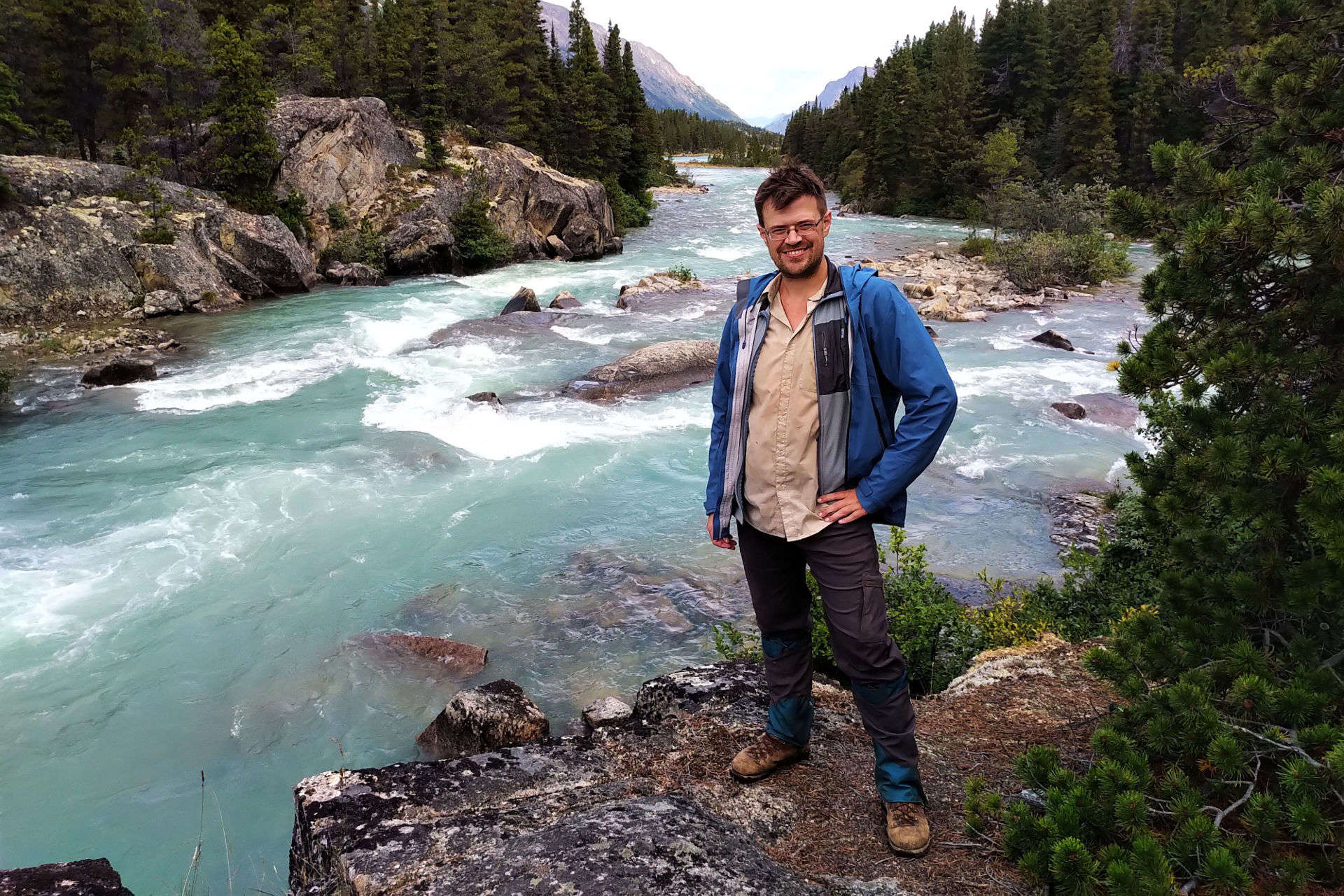My Victoria Day long weekend was spent at Golden Ears Provincial Park near Maple Ridge, British Columbia. I’ll diarise about that another time; suffice to say it was a bust. There were clouds and bugs but most of all there was a crowd; a happy, rowdy pain-in-the-ass. At a spacious campground 45 minutes from the nearest parking lot people gave up and went home by three in the afternoon. The survivors seemed like nice people; the problem is that they were there. Enjoying the outdoors in their own way so, just by being around, we made that enjoyment a bit less for each other.
This was obviously going to happen. Golden Ears is a popular park, being gorgeous, easy to access and getting easier, and possessed by that enormous mass popularity of many local nature spots. Golden Ears, like Garibaldi and Alice Lake and oh God I’m going to stop listing them before I get depressed, is going to be too popular to be fun a lot of the time. The same applies for many day-hiking spots in the Vancouver area, and here I’m particularly thinking of the Lynn Canyon Suspension Bridge and the beautiful Quarry Rock viewpoint. The /r/Vancouver Reddit thread on Quarry Rock Victoria Day gave me all the bad feelings. And, going not that much further afield, the world-famous West Coast Trail is renowned as a hotspot for all the bad things the phrase “world-famous” implies in hiking culture.
Of course, backpacking in Golden Ears is an immensely popular overnight experience, so there is a cost attached. That cost is, um, $5 a night. Paid, by the way, essentially on the honour system.
Now, as the saying goes, “you aren’t being delayed by traffic, you are traffic.” All of us who visit these places, save the litterbugs and dirtbags, are equally guilty of contributing to the crowd. That is not the point, as we all recognize. The problem is that a great mass of humanity crowding into nature ruins it for everyone, diminishes the purpose of the experience. It’s the tragedy of the commons and that means that, while all would-be campers may be individually blameless, some must still be kept out.
It’s cold to say but what’s the alternative? Finding ever-more obscure places for our long weekend fun? That’s the default solution, except it’s 2018 and some yahoo with a blog finds out about your obscure place, writes about his time there, it accidentally goes viral, and then it’s all over. All these places started as locals’ favourites. Besides, blazing new trails will always be the perfect weekend for some but others want to follow markers down established paths.
The only answer is to ration access to these popular places. And should that sound shocking, remember that rationing is what we have already. It just isn’t applied systematically.
When I did the West Coast Trail last year I booked my trip, what, three days before I left? It went great and I had a lovely time. But it was shoulder season, on no particular day, and I was able to come up with a non-trivial amount of money on no notice. That trail was rationed based on your ability to write a cheque for CDN$184 plus the costs of travel and, thanks to a limit of 75 people starting from each trailhead each day, either your flexibility or your ability to plan ahead. This summer another person and I are doing the Chilkoot Trail between Skagway, Alaska and Bennett, British Columbia; the cash cost was less but we’re going on a premium summer weekend and I had to be on the phone the hour reservations opened up. There are a limited number of spots and we got two of them by foresight; what is that if not rationing? And it stinks for the working stiff this summer who puts in a bunch of overtime and, suddenly finding he can take a five-day weekend, looks for an adventure.
That’s what we have to remember. This is all rationed, today, even if it’s only so far as “if you actually want the experience, you have to take it on a cloudy Tuesday morning or loiter on the rock for four hours.” Whether it’s rationed more by cash (the WCT) or patience and free time (Vancouver) or the ability to plan ahead (the Chilkoot), it’s rationing. You can’t say “everyone should have access to these popular places” and dust your hands off, because that world doesn’t exist. Finite resources are finite, who knew; the question is how best to distribute them.
Mount Everest, for example, rations by plan-ahead-ability and heavily by cash. You can still book a guided climb of Everest in April 2019 with a world-leading company from Nepal, but it’ll cost you US$65,000 a man exclusive of getting to and from Kathmandu. Just a permit for just the mountain costs US$10,0001. Despite that colossal cost, despite this trip being unthinkable for anyone outside the global 0.01%, the slopes of Everest are still strewn with trash and corpses, while tents are pitched in marital intimacy in the established camps. If the cash cost is meant to make the mountain pleasantly quiet then it is too low.
But if you charged every dollar the traffic up Everest would bear, all the lawyers and doctors and people-we-delude-ourselves-into-thinking-we-could-be who do Everest would be replaced by multi-millionaires. If you put a fare gate leading up to Quarry Rock and charged whatever amount of cash it takes to keep the experience enjoyable, holiday Mondays would get exclusively tour buses of Shanghai’s best snapping shots of Indian Arm with their iPads. There are cases when that might be fine (restrict the Grouse Grind to real estate agents paying $30 a climb? Oh well!) but not many. Capitalism, alone, is not an adequate answer, right?
Well, maybe. As we know there are plenty of views as good as those you see from Quarry Rock. Not all of them are as easy to get to but Quarry Rock itself was a bit of a hassle until it got popular. The West Coast Trail, infamously, has gotten easier every year, and I found it “not the toughest hike I’ve done with a terminus in Port Renfrew, British Columbia in 2017.” Given the right incentives, many sites could share the load currently heaped onto a few.
Deep Cove and the Lynn Canyon Suspension Bridge and all those teeming-with-hell’s-debris places in greater Vancouver are busy partially because of international tourism, because they are easy to reach and free to the user2. Changing that equation changes the results. The Capilano Suspension Bridge, which is privately owned and charges a fee, has to compete for tourist business against a public park a twenty-minute drive away that gives it up for free. Nothing about this sounds right.
And you’re right, nothing sounds good about charging a single mom working at 7-11 twenty bucks a head to bring her family to a popular park either. But her community can arrange to put $60 more in her pocket so she can see that park, or however she chooses to help her children, more easily than getting them a sunny Thursday morning in the fall off work and school because that’s the only way they can see a free park the way it should be seen.
We act like going into nature is some deeply spiritual, uplifting experience, because for many of us it is. For many more it’s a nice way to spend a weekend, which is why they babble on their cell phones or bring cases of Pilsner along or view it all through their iPads. They could just as easily be going to the movies or watching Hamilton. Why? Because we subsudize parks even more than we subsidize Hamilton, and who wouldn’t save a buck on a day’s entertainment?
Again, tacking fees onto trails until the crowds reduce and we’re happy is not a complete solution. But when we complain that the Black Tusk is more man than rock on Dominion Day, these are the terms we need to think in. The mountain is already rationed. Are we rationing it as efficiently as we could be?
- The situation through Tibet is different, but that route is more of a hassle on a few different levels so people avoid it who can.
- The Grouse Grind, less so, but the Grouse Grind is fundamentally a fitness experience, not a natural one, and everyone going knows that. It’s the gym with better air and you pay $15 to go back down anyway.




One reply on "The popularity problem"